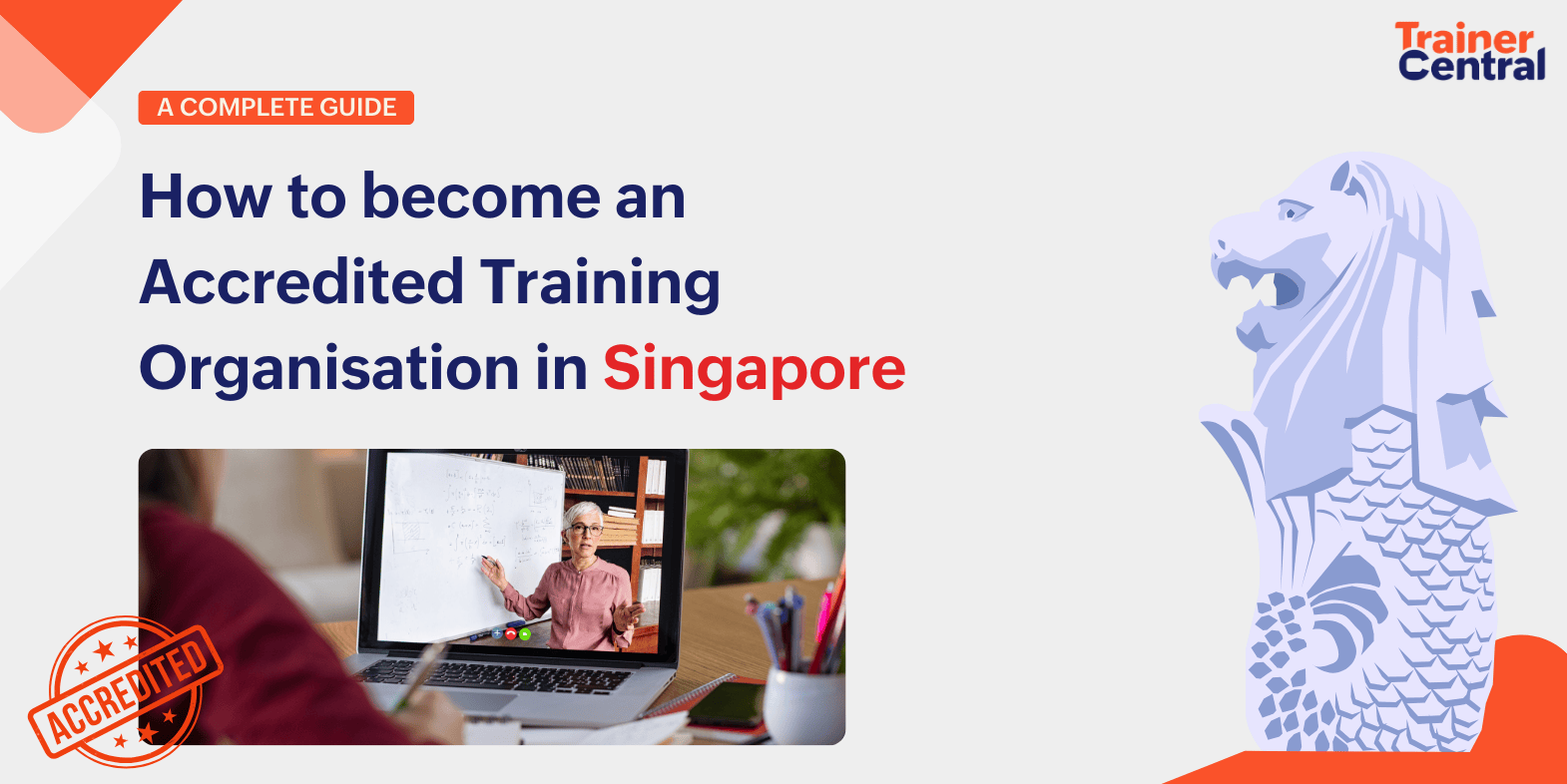- HOME
- E-Learning trends
- How to become an Accredited Training Organisation in Singapore
How to become an Accredited Training Organisation in Singapore
- Last Updated : May 23, 2025
- 1.5K Views
- 6 Min Read

Singapore’s learning economy is among the most advanced in the world, and with the government’s emphasis on continuous upskilling, training providers play a crucial role in national workforce development. To ensure that the quality of adult education meets industry standards, SkillsFuture Singapore (SSG) regulates and accredits select providers as Accredited Training Organisations (ATOs).
Achieving ATO status is more than just a certification—it's a strategic milestone that positions your institution to offer Workforce Skills Qualifications (WSQ) courses that are eligible for government funding and nationally recognized credentials. This blog post explores the essential requirements, application procedures, and long-term responsibilities involved in becoming an ATO in Singapore.
Understanding what an ATO is
An ATO is a designation granted by SkillsFuture Singapore to training providers that meet stringent quality benchmarks in curriculum design, trainer qualifications, assessment methods, and administrative operations. ATOs are officially authorised to deliver WSQ-accredited programmes and issue certifications under Singapore’s national skills framework.
Strategic advantages of becoming an ATO
For training providers in Singapore, ATO accreditation is not just a regulatory badge—it opens tangible doors to growth, funding, and impact. It gives you an edge in a competitive market by embedding your brand into the national workforce development agenda.
Here are the key advantages of ATO status:
Access to national funding
ATO status enables your learners to access subsidies and SkillsFuture Credit, which significantly reduces the cost barrier for training. This, in turn, increases enrolment and appeal for both individuals and enterprises.
Recognition as a quality-driven provider
SSG accreditation signals that your institution adheres to rigorous quality and instructional standards. This enhances your reputation and positions your brand as a trustworthy provider in a competitive marketplace.
Preferred vendor for corporate and government clients
Many companies and government agencies prioritise ATOs when selecting training providers. Securing this accreditation can open doors to long-term partnerships, procurement opportunities, and participation.
Scalable programme development
With ATO accreditation, you can develop modular, stackable WSQ programmes that align with evolving industry needs, letting you continuously expand your offerings across sectors while maintaining compliance with national standards.
Eligibility requirements for ATO accreditation
Before applying for ATO status, organisations must demonstrate that they meet the baseline operational, instructional, and quality standards set by SSG. These prerequisites ensure that training providers can maintain consistent educational excellence and accountability.
To be eligible, your organisation must satisfy the following criteria:
Legal registration
Your institution must be legally registered as a business entity in Singapore and possess a valid Unique Entity Number (UEN).
Operational and financial viability
You must demonstrate financial soundness and a verifiable track record in delivering education, training, or related services.
Curriculum alignment with WSQ frameworks
Courses must align with relevant technical skills, competencies, and Critical Core Skills (CCSs) within the WSQ framework. This ensures that training outcomes are consistent with industry standards.
Trainer qualifications
All trainers must hold the Advanced Certificate in Learning and Performance (ACLP) or an equivalent adult educator qualification. Subject matter expertise and experience in adult learning methodologies are also required.
Internal quality assurance systems
Your organisation must have well-documented systems in place for curriculum development, assessment design, learner support, evaluation processes, and continuous improvement.
ATO application process: Step by step
The journey to becoming an ATO involves a structured and detailed process. This ensures that only organisations with the right systems, staff, and curriculum alignment receive approval. Below is a streamlined breakdown of what to expect.
Step 1: Understand the WSQ ecosystem
Begin by familiarising yourself with the WSQ frameworks. Each framework outlines competencies, job roles, and the required skills for specific sectors. Choose the framework that best aligns with your intended courses.
Step 2: Design WSQ-aligned courses
Courses must align with identified competencies. This involves:
- Mapping learning outcomes to specific technical skills, competencies, and CCSs
- Outlining a clear, modular curriculum
- Establishing a structured and transparent assessment method
At this stage, collaboration with instructional designers and subject matter experts is essential to ensure pedagogical and regulatory alignment.
Step 3: Prepare qualified trainers and assessors
Your trainers must hold ACLPs or an equivalent adult learning qualification and be proficient in both subject matter and instructional delivery. Additionally, certified assessors must be appointed to conduct assessments in accordance with SSG’s standards for validity, reliability, and consistency.
Step 4: Complete the Organisation Registration checklist
This is a self-evaluation checklist required by SSG to assess:
- Governance and management systems
- Curriculum design procedures
- Facilities and training environments
- Trainer competency and development plans
- Learner support services and feedback mechanisms
You'll need to provide supporting documents such as financial statements, organisational charts, training standard operating procedures, and trainer credentials.
Step 5: Submit your application via TPGateway
Applications are submitted through TPGateway, the central portal for training providers. Upload all required documents, including your completed checklist, course outlines, assessment plans, trainer profiles, and organisational policies. The application fee is non-refundable.
Step 6: SSG audit and evaluation
SSG will review your submission through:
- Desktop audits of documentation
- Site audits (either virtually or on-site)
- Interviews with key personnel, including management, trainers, and assessors
- Evaluation of course materials and assessment frameworks
The audit ensures that your organisation complies with the national standards for training delivery and assessment.
Step 7: ATO accreditation
Upon successful completion of the evaluation, you will receive formal accreditation as an ATO. Your organisation will also be listed in SSG’s public directory of Approved Training Organisations, which serves as a reference point for learners, businesses, and funding agencies.
Delivering WSQ courses after accreditation
Becoming an ATO is only the beginning. Delivering WSQ-certified programmes requires ongoing compliance with strict operational and reporting standards to maintain eligibility for funding and accreditation.
Training can be delivered in-person or online, as long as the delivery model adheres to SSG’s guidelines for engagement, tracking, and assessment. ATOs can also leverage LMS and online course creation platforms like TrainerCentral to conduct live virtual classes and manage online learner progress effectively.
Course run submissions
Each instance of a course, also known as a course run, must be pre-approved via TPGateway. This includes submitting the schedule, trainer assignments, venue details, and expected class size.
Learner registration and attendance tracking
You are required to use prescribed systems to accurately capture learner information and attendance records. This data is essential for audit purposes and grant eligibility.
Assessment and certification procedures
All assessments must follow WSQ-prescribed methodologies. Scoring must be documented, moderated, and stored securely. Learners who successfully complete the course and assessments are issued official WSQ certificates.
Claims and reimbursement
Eligible ATOs can submit funding claims via TPGateway. These include SkillsFuture Credit claims for individual learners and Absentee Payroll claims for employers who release employees to attend training.
Sustaining your ATO status
Maintaining ATO status requires more than just administrative upkeep; it involves a culture of accountability, learner-centric practices, and ongoing enhancement of programme quality.
Periodic audits
SSG conducts annual or periodic audits to ensure continued adherence to training, assessment, and administrative standards.
Expanding or renewing accreditation
If you want to offer new courses or extend into additional industry frameworks, you must undergo a scope expansion or re-accreditation process.
Continuous quality enhancement
Establish mechanisms for collecting feedback from learners and trainers. Use this data to refine course materials, improve delivery effectiveness, and enhance learner satisfaction.
Common challenges and how to overcome them
While ATO accreditation brings long-term value, training providers often encounter several operational and strategic challenges during the application process.
One of the most common hurdles is the volume and complexity of documentation required. Providers must prepare detailed course outlines, assessment rubrics, and internal standard operating procedures. To streamline this process, many organisations work with instructional designers or consultants who specialise in WSQ compliance and can ensure accuracy and completeness.
Another frequent issue involves trainer qualification gaps. Subject matter experts may lack ACLP accreditation. Organisations should invest in staff development by sponsoring trainers for the ACLP course or, alternatively, engage certified freelance trainers while internal resources are being developed.
In some cases, courses may not initially align well with WSQ frameworks. The best solution is to revise the course structure, ensuring that learning outcomes, content, and assessments are mapped to appropriate technical skills, competencies, and core skills.
Finally, delays in processing the application, often due to incomplete submissions or a lack of internal readiness, can extend timelines significantly. Training providers should begin preparations early, assign dedicated project leads, and double-check every submission item before uploading it to TPGateway.
Final thoughts
For training providers aiming to establish a lasting presence in Singapore’s education landscape, ATO accreditation is both a mark of excellence and a gateway to scale. It enables access to national funding mechanisms, enhances your reputation, and integrates your offerings into the broader SkillsFuture ecosystem.
While the accreditation process demands careful planning, investment in quality systems, and an unwavering commitment to standards, the long-term returns in credibility, opportunity, and impact make the journey worthwhile. By becoming an ATO, you're not just running a training business; you're becoming a key contributor to Singapore’s vision for a skilled, future-ready workforce.


